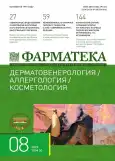Современные подходы к лечению тяжелых форм ихтиоза у детей
- Авторы: Боткина А.С.1,2, Гуменная Э.Р.2, Дубровская М.И.1
-
Учреждения:
- Российский национальный исследовательский медицинский университет им. Н.И. Пирогова
- Российская детская клиническая больница
- Выпуск: Том 30, № 8 (2023)
- Страницы: 110-115
- Раздел: Проблема
- URL: https://journal-vniispk.ru/2073-4034/article/view/275574
- DOI: https://doi.org/10.18565/pharmateca.2023.8.110-115
- ID: 275574
Цитировать
Аннотация
Врожденные ихтиозы представляют собой гетерогенную группу наследственных нарушений ороговения различной степени тяжести, характеризующиеся генерализованным шелушением, гиперкератозом и часто воспалением кожи. Ихтиозы обусловлены различными мутациями более чем в 50 генах, кодирующих структурные белки и ферменты эпидермиса, участвующие в поддержании и регуляции барьерной функции кожи. Нарушение строения эпидермиса приводит к повышенной трансэпидермальной потере воды, усилению ксероза и шелушения. В настоящее время не существует специфических методов лечения, позволяющих полностью вылечить пациента с ихтиозом. Используются различные местные средства, позволяющие уменьшить сухость, шелушение, гиперкератоз и трансэпидермальную потерю воды. За последние годы достижения науки изменили понимание патогенеза ихтиоза и позволили по-иному взглянуть на подходы к терапии с использованием противовоспалительных биологических препаратов, малых молекул и заместительной генной терапии. В обзоре рассмотрен механизм фармакологического действия лекарственных препаратов, применяемых в лечении ихтиоза, а также представлены собственные данные применения инновационных методов лечения тяжелых форм ихтиоза у детей.
Ключевые слова
Полный текст
Открыть статью на сайте журналаОб авторах
Александра Сергеевна Боткина
Российский национальный исследовательский медицинский университет им. Н.И. Пирогова; Российская детская клиническая больница
Автор, ответственный за переписку.
Email: botkina@gmail.com
ORCID iD: 0000-0001-6890-2041
к.м.н., доцент кафедры госпитальной педиатрии им. акад. В.А. Таболина педиатрического факультета
Россия, Москва; МоскваЭ. Р. Гуменная
Российская детская клиническая больница
Email: botkina@gmail.com
Россия, Москва
М. И. Дубровская
Российский национальный исследовательский медицинский университет им. Н.И. Пирогова
Email: botkina@gmail.com
ORCID iD: 0000-0002-3487-2451
Россия, Москва
Список литературы
- Vahlquist A., Torma H. Ichthyosis: A Road Model for Skin Research. Acta Derm Venereol. 2020;100(7):adv00097. doi: 10.2340/00015555-3433.
- Dabas G., Mahajan R., De D., et al. Managing syndromic congenital ichthyosis at a tertiary care institute-Genotype-phenotype correlations, and novel treatments. Dermatol Ther. 2020;33(6):e13816. doi: 10.1111/dth.13816.
- Oji V., Tadini G., Akiyama M., et al. Affiliations expand. Revised nomenclature and classification of inherited ichthyoses: results of the First Ichthyosis Consensus Conference in Soreze 2009. J. Am. Acad. Dermatol. 2010;63(4):607–41. doi: 10.1016/j.jaad.2009.11.020.
- Mazereeuw-Hautier J., Hernandez-Martin A., O’Toole E.A., et al. Management of congenital ichthyoses: European guidelines of care: part two. Br J Dermatol. 2019;180(3):484–95. doi: 10.1111/bjd.16882.
- Vahlquist A., Fischer J., Torma H. Inherited nonsyndromic ichthyoses: an update on pathophysiology, diagnosis and treatment. Am J Clin Dermatol. 2018;19(1):51–66. doi: 10.1007/s40257-017-0313-x.
- Sun Q., Ren I., Zaki Th., et al. Ichthyosis affects mental health in adults and children: A cross-sectional study. J Am Acad Dermatol. 2020;83(3):951–54. doi: 10.1016/j.jaad.2020.01.052.
- Abeni D., Rotunno R., Diociaiuti A., et al. A multicenter study on quality of life of the «greater patient» in congenital ichthyoses. Orphanet. J. Rare Dis. 2021;16(1):440. doi: 10.1186/s13023-021-02085-9.
- Troiano G., Lazzeri G. A review of quality of life of patients suffering from ichthyosis. J Prev Med Hyg. 2020;61(3):E374–78. doi: 10.15167/2421-4248/jpmh2020.61.3.1450.
- Zaenglein A.L., Levy M.L., Stefanko N.S., et al. PeDRA Use of Retinoids in Ichthyosis Work Group. Consensus recommendations for the use of retinoids in ichthyosis and other disorders of cornification in children and adolescents. Pediatr Dermatol. 2021;38(1):164–80. doi: 10.1111/pde.14408.
- Cave A., Plumptre I., Mellerio J.E., et al. The adverse effect profile of acitretin in a pediatric dermatology population-Longitudinal cohort study and recommendations for monitoring. J Am Acad Dermatol. 2020;83(6):1779–81. doi: 10.1016/j.jaad.2020.03.082.
- Paller A.S., Renert-Yuval Y., Suprun M., et al. An IL-17-dominant immune profile is shared across the major orphan forms of ichthyosis. J Allergy Clin Immunol. 2017;139(1):152–65. doi: 10.1016/j.jaci.2016.07.019.
- Malik K., He H., Pavel A., et al. RNAseq profiling highlights immune and barrier differences among ichthyoзses. J Invest Dermatol. 2020;3(3):11. doi: 10.29024/jsim.65.
- Kim M., Mikhaylov D., Sun M., et al. Ichthyosis transcriptome reveals increased atherosclerosis markers and immune and barrier differences amongst subtypes. J Inves. Dermatol. 2021;141(5):S21. doi: 10.1016/j.jid.2021.02.137.
- Paller A.S. Profiling Immune Expression to Consider Repurposing Therapeutics for the Ichthyoses. J Invest Dermatol. 2019;139(3):535–40. doi: 10.1016/j.jid.2018.08.027.
- Luchsinger I., Knopfel N., Theiler M., et al. Secukinumab Therapy for Netherton Syndrome. JAMA. Dermatol. 2020;156(8):907–11. doi: 10.1001/jamadermatol.2020. 1019.
- Volc S., Maier L., Gritsch A., et al. Successful treatment of Netherton syndrome with ustekinumab in a 15-year-old girl. Br. J Dermatol. 2020;183(1):165–67. doi: 10.1111/bjd.18892.
- Samuelov L., Shehadeh W., Sarig O., et al. Ustekinumab therapy for Netherton syndrome. J Dermatol. 2023;50(4):494–99. doi: 10.1111/1346-8138.16645.
- Barbieux C., des Claustres M.B., de la Brassinne M., et al. Duality of Netherton syndrome manifestations and response to ixekizumab. J Am Acad Dermatol. 2021;84(5):1476–80. doi: 10.1016/j.jaad.2020.07.054.
- Fontao L., Laffitte E., Briot A., et al. Infliximab infusions for Netherton syndrome: sustained clinical improvement correlates with a reduction of thymic stromal lymphopoietin levels in the skin. J Invest Dermatol. 2011;131(9):1947–50. doi: 10.1038/jid.2011.124.
- Submuth K., Traupe H., Loser K., et al. Response to dupilumab in two children with Netherton syndrome: Improvement of pruritus and scaling. J Eur Acad Dermatol Venereol. 2021;35(2):e152–55. doi: 10.1111/jdv.16883.
- Murase Ch., Takeichi T., Taki T., et al. Successful dupilumab treatment for ichthyotic and atopic features of Netherton syndrome. J Dermatol Sci. 2021;102(2):126–29. doi: 10.1016/j.jdermsci.2021.03.003.
- Di W.-L., Lwin S.M., Petrova A., et al. Generation and Clinical Application of Gene-Modified Autologous Epidermal Sheets in Netherton Syndrome: Lessons Learned from a Phase 1 Trial. Hum. Gene Ther. 2019;30(9):1067–78. doi: 10.1089/hum.2019.049.
Дополнительные файлы















